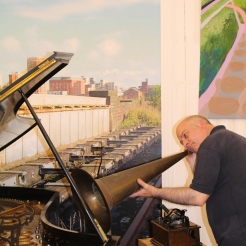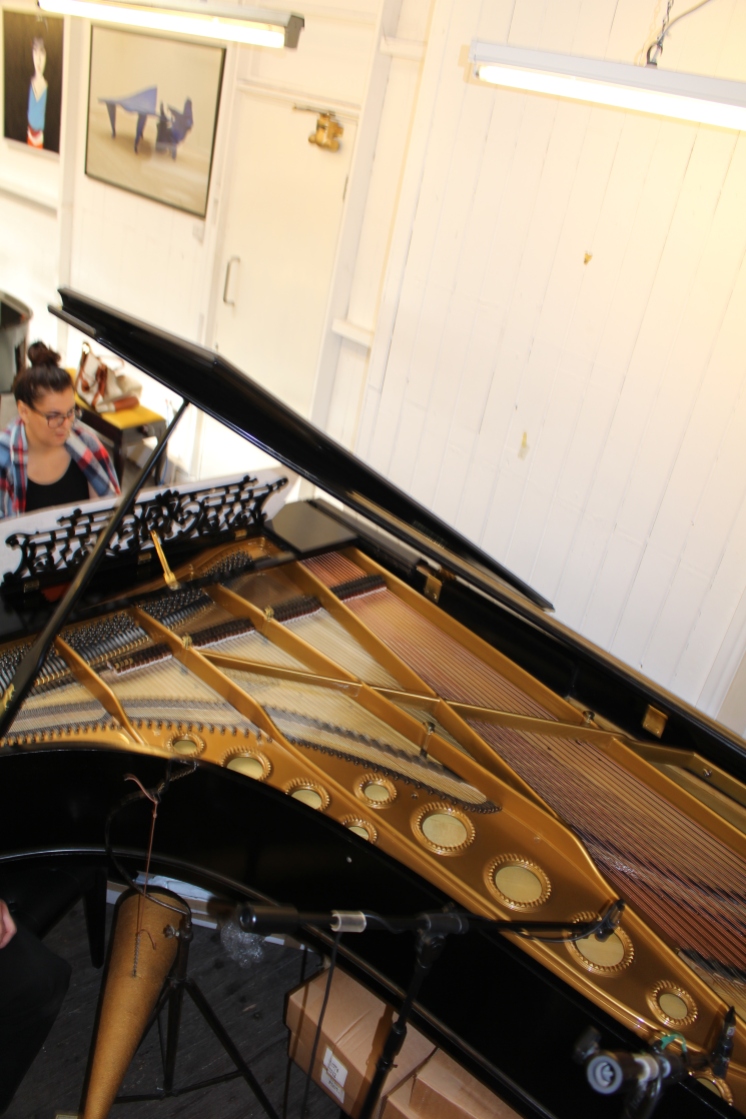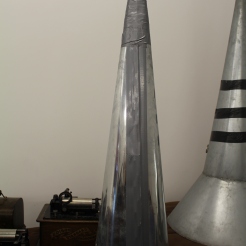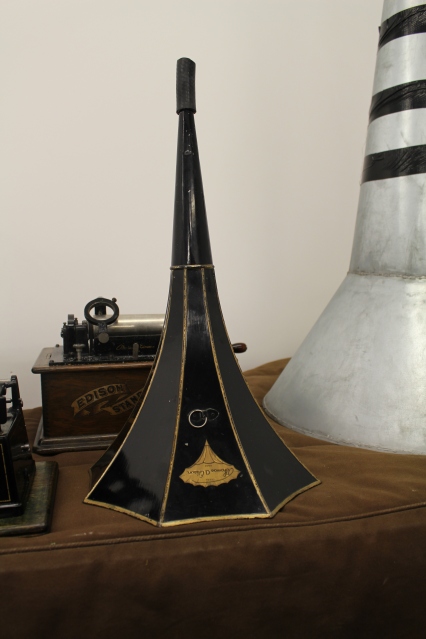Background research:
In the first year of the research project, the (re)construction was based on the historic recordings made by Julius Block (1858-1934). It was generally believed that Block’s cylinders had been destroyed during the Second World War, but John Maltese and John Anthony Maltese discovered that the cylinders had been confiscated by the Russians after the war, and taken to St. Petersburg, where they were stored in The Phonogram Archive of the Institute of Russian Literature of Academy of Sciences. In 2005, John Maltese, Ward Marston and Scott Kessler gained access to this archive, and Marston’s record company published a CD with a selection of Block’s recordings in 2008.
There are several reasons for choosing these recordings as a starting-point: 1) they are widely known, following the publication of the Cd by Marston Records; 2) it was not possible to reconstruct a commercial recording studio from the end of the nineteenth century due to a lack of suitable space, equipment and financial demands. Block’s recordings therefore seemed ideal; he was an amateur recording enthusiast, and his cylinders were produced with a relatively small selection of equipment, in conditions which could be largely approximated and recreated. Importantly, given Block’s status as enthusiastic amateur, this case-study reasonably claims historical authenticity in one significant matter – it required and involved a degree of experimentation, trial-and-error, and failure that goes hand-in-hand with the spirit of the phonographic soirées in the early 1890s; 3) Block’s cylinders demonstrate how difficult it is to establish some of the finer details relating to how early recordings were produced.
Who was Julius Block?
The case-study started out with lengthy musicological research into both Block and his recording technologies and techniques. This part of the project was supported with information from Block’s unpublished memoirs and a series of letters exchanged between Block and Thomas Edison.

Julius Block was born in Pietermaritzburg, KwaZulu-Natal, in 1858, and died in Vevey, Switzerland, in 1934. As a young man, he had hopes for becoming a musician but his father, a wealthy businessman who represented two American trading companies in Russia, insisted that he devotes his life to their companies. The family business, specialising in research and innovations, flourished, and he was a wealthy man. Block’s company brought the first bicycles, cotton gin, elevators and sawing machines to Russia. His interest in music never ceased, and after getting a phonograph from Edison, Block produced a collection of wax cylinders that are of outstanding importance in the history of recorded music.
In 1889, Block was on a business trip in New York, and he sent an introductory letter to Thomas Edison at his laboratory in Orange, NJ. The two men met on July the 23rd, and Block purchased an Electric Phonograph, or class M machine. Although he took his new machine with him, some parts were subsequently delivered by mail, and it is notable that he did not purchase a listening tube or any funnels; he arranged for these to be made once back in Russia.
Block’s diary does not provide information on the details of his recording sessions. However his letters to Thomas Edison, and his assistant Charles Batchelor, are extremely useful when understanding which equipment he used. For example, the motor on Block’s phonograph required a steady current of two and a half volts and two amps, and this was delivered by a grenet cell battery. Through his letters to Edison, we learn that he had many problems with this battery, and struggled to make a solution that would successfully run the phonograph. Through time, however, Block overcame all of these difficulties, and he learned how to run the phonograph successfully.
Once he mastered the art of recording, Block used his phonograph from 1889 to 1927. His cylinders contain recordings of Anton Arensky, Paul Pabst, Sergei Taneyev, Leo Conus, Jules Conus, Anna Esipova, Jan Hrimaly, Anatoly Brandukov, Elizaveta Lavrovskaya, and Paul Juon. These are also the earliest surviving recordings of Josef Hofmann, Nikolai Figner, Eddy Brown, and Egon Petri. Importantly, Block’s recordings include the first recorded performances of Bach, Chopin, Mendelssohn, Schumann, Tchaikovsky, Wagner, Donizetti, Verdi, Bizet, and Arensky. Block had visionary views of the phonograph, and thought it could be used to aid practise, composition, and even scientific research.
Pilot study
A pilot study was conducted in order to test everything that would form a part of an initial case-study. It involved a practical experiment, and was extremely valuable to the rest of the project; it showcased a range of imperfections which were assumed in the (re)construction, as well as in the make of the transfers. Mistakes made in the pilot study were crucial for understanding the overall mechanical recording processes, wax cylinders and their transfers. The pilot study was conducted through a simulation of mechanical recording process, in which a series of piano performances were captured using both mechanical and digital recording technologies.
Three pieces were chosen, each relating to a recording made by Block: Anna Essipova (1851-1914) playing Godard’s Gavotte in G, Op.81 No.2 (C136, 15 November 1898), Anton Arensky (1861-1906) playing his own Nocturne in D-flat, Op. 36 No.3 (C114, 25 November 1894) and Leonid Kreutzer’s (1884-1953) cylinder of Chopin’s Mazurka in G minor, Op. 67 No. 2 (C141, 1915).
The wax cylinders were made with:
- an Edison Cylinder Standard Phonograph from 1906
- various recording horns (in order to test different sound qualities)
- a Bechstein piano (1882, fully restored by a specialist piano maker from Besbrode Pianos in Leeds, UK)
- a pair of AKG414 and a pair of Neuman 184 microphones; a Steinberg UR22 soundcard; and DAW and a wave-editor.
The pilot study aimed to answer the following research questions:
- What is the value of early recordings in performance practice research? How can such recordings be used in research and to what extent might they be relied upon as research sources?
- How might one reconstruct an early recording process, using a wax cylinder, to understand how the original recording was made? Does such a reconstruction allow for a greater understanding of the original recording process?
- Are there certain methods for the analysis of early recordings, derived from the process of reconstruction, that allow performer-researchers to develop a greater understanding of other recordings, and the types of performances they preserve?
The instrument:
Block’s memoirs and letters do not provide any information about the piano, or pianos, used for his recordings. This lack of information was compounded by the fact that the recordings chosen for both pilot study and the case-study were made between 1894 and 1915 in different countries. With this in mind, it was difficult to make an informed decision about which instrument would be most suitable for the reconstructions.
Even though it is more demanding to record a grand piano with a phonograph, it is more than rare to find an upright from the end of the nineteenth century that is in a suitable condition for recording. Not knowing which piano Block owned, it was safe to assume that a family of Block’s status would have a grand piano. Acordingly, I hoped that I could locate a Russian piano of the late nineteenth century, such as Becker, Diedrich and Schreder. Unfortunately, since these instruments were only produced in Russia, and were never particularly popular in Europe, I was not able to get hold of one. Even so, it is highly probably that a notable family of the time would own a German or French instrument, such as Pleyel, Blüthner, or Bechstein. Furthermore, a choice of instrument should not be entirely guided by make and model. Rather, the choice should be made guided by the quality of the instrument, as pianos made at the end of the nineteenth century are not always well-preserved, or badly restored.
Luckily, I managed to find a beautiful Bechstein from 1882, restored by Besbrode Pianos, in Leeds. The instrument was played by Maestro Liszt himself, and more information about this amazing instrument can be found here. I would like to thank Bestrode Pianos for their kind loan of this wonderful instrument, it was more than an amazing opportunity to have and I am indeed very grateful for it!
The recording session:
We started bright and early to try the instrument and various funnels.
On the photos we can see Duncan Miller, Vulcan Records, who was recording on cylinders that he has produced. We can see here how the different horns were tested, and what the recording process looked like. We ran a lot of tests in order to see what will best capture the sound of the piano. The position of the recording horn is extremely important, as well as the temperature in the room which will dictate how the wax will be cut – and how deep the grooves will be.
Even though it was early July, the room temperature was lower than we hoped for, which meant that I had to play everything very loud in order to be register on the cylinders. Luckily, I was offered a blanket from the Besbrode shop to keep myself warm (as you can see on the photo below)!
Unfortunately, phonographs do not have a magic button which controls their speed. It is crucial to make the cylinders on the same number of revolutions per minutes (rpm) that they will be reproduced at. In order to make sure that we were using the exactly the same rpm, Duncan made a lot of measuring throughout the session:
At the same digital recordings were made, as explained above. The microphones were moved around in the preparatory part of the session, but once we established where the funnels would be placed the microphones were not moved. All the digital recordings were made by my husband, Dr. Adam Stanovic from the University of Sheffield, who also took all of the photos used on this website.
Some more photos from the session:
And what now?
The pilot study was very successful, and it prepared us for the first case-study which took place a few months later. There are, as always in research and practice, a few factors which unsatisfactory:
- Firstly, the room temperature was quite low and it was difficult to record like that – even though the piano was extremely loud, it was physically demanding to record in such circumstances. The decision was made that the next time the conditions need to be more ‘cylinder friendly’.
- Secondly, I decided to try out more equipment next time – different phonographs, cutters, reproducers and funnels. As I see the process of (re)construction as something that is never entirely possible, I decided to try out different paths in mechanical recording session and see how much this influences my interpretational choices. Even though we tried out a range of different funnels (as shown in the photos above), we decided on a funnel which would get us the best results under the circumstances (the copper funnel with a flange). I thought it might be very interesting to actually register my playing with all the equipment we can get hold of, in order to show the differences between them – how exciting!
- Lastly, the transfers were not made in situ, as the shop was closing by the time we finished our session. Decision was made that all the transfers are going to be done just after recording of the cylinders next time – in order to get the closest sonic picture possible to original cylinders.
Overall, this was a extraordinary experience, and we could not wait to continue with the case-study to follow.
Case-study
The first case-study in this three year project is a continuation of the pilot study made earlier; it is again based on the reconstruction of historic recordings made by Julius Block (1858-1934). The following pieces were chosen to be recorded with a range of phonographs:
- Anna Esipova (1851-1914) performing Benjamin Godard’s Gavotte in G, Op. 81 No. 2 (C136, 15 November 1898) in the apartment of Julius Block in Moscow. This cylinder is her only surviving recording, beside the piano rolls she has made for Welte-Mignon in the early 1900s. One of the leading piano figures of her time, Esipova had coaching from Franz Liszt and Theodor Leschetizky, and had a fruitful career as a pianist and educator. Her Block cylinder is a great example of her musical personality and amazing piano technique.
- Anton Arensky (1861-1906) performing his own Nocturne in D flat, op. 36 no. 3 (C114, 25 November 1894). This cylinder exemplifies Block’s efforts to preserve composer’s interpretations of their own musical works.
- Leonid Kreutzer’s (1884-1953) cylinder of Frédéric Chopin’s Mazurka in G minor, op. 67 no. 2 (C141, 1915). Kreutzer was a well-known pianist and educator, and a student of Esipova, Glazunov and Rachmaninov.
- Paul Pabst (1854-1897) playing Robert Schumann’s ‘Chopin’, from Carnaval, op. 9 (C123, 12 February 1895). Pabst was a prominent pianistic figure in Moscow, known as a pianist, educator and composer. As in the pilot study, all transfers used were made by Ward Marston, and published on the CD “The Dawn of the Recording. Julius Block Cylinders”
The instrument:
For this case-study, a Streicher was used. Made in 1881 (8187, length: 203cm, width: 140cm), this instrument was chosen due to its size and, significantly, timbre. The recording session was conducted in the Early Music Room at the University of Huddersfield, which was much smaller than the room used for the pilot study, being 5m by 5m. Again, however, the balance between the instrument’s size and the room seemed appropriate. The temperatures of the rooms differed: 14 °C in the pilot study, and 22.8 °C in the case study. This directly influenced level of sound registered on the cylinders.
Mechanical equipment:
- Copper horn string wound, 660mm by 190mm
- Small steel horn, 480mm by 130mm
- Narrow zinc horn, 130mm by 890mm
- Large zinc horn, 280mm by 1100mm
- Large steel flared horn, 1450mm by 580mm
- Brass flared horn, 762mm by 355mm
All of these horns had to be tested, according to the room and instrument, which took quite a while:
The other mechanical equipment included:
- single reproducing horn, made of steel (290mm by 485mm)
- three different recorders
- two different reproducers
I was unable to use the Class M type phonograph which Block used to have, due to its rarity and high price. Since differences between the electric and the spring phonographs are largely related to the source of power, their respective bodies remains the same. I subsequently decided to use a spring motor phonograph; the Triumph Edison (Model B) Phonograph (height: 14 3/8 inches, base: 18 1/8 by 12 3/4 inches; net weight 49 lbs) had powerful triple springs which would allow the listener to go through fourteen records with a single winding. It came with removable steel bushings and a belt tightener and was closest to the model M owned by Block. For reasons explained above, three additional phonographs were used alongside the Triumph. These included the Gem, Standard and Fireside models.
The Gem Edison (Model B) Phonograph was the cheapest ($10.00) and the smallest available machine on the market (height: 8 3/4 inches, base: 9 3/8 by 7 3/8 inches; weight net 13 lbs.). It was fitted with a spring motor and start-stop regulating device. The Standard Edison (Model A) Phonograph ($20.00) was bigger in size (height: 10 3/4 inches, base: 12 3/4 by 8 3/4; net weight 20 lbs.). It was made with a new style cabinet and carrying cover, and it was easy to operate as it had a hinged cover which could be opened, permitting instant inspection of the motor. This model was originally made for recording, and came with a sapphire shaving knife and Model C reproducer. The Fireside Edison (Model B) Phonograph ($20.00) was invented to replace the Standard. This never happened, but the Fireside was extremely popular as it was compact (height: 11 inches, base: 11 3/4 by 9 1/4 inches; net weight 18 lbs) and had several improvements, including a new style clip from body to cover.
Digital equipment and transfers:
Known widely as a ‘transfer’ or ‘digitisations’, digital technologies are used to record early recording technologies, such as phonographs, when they play-back recordings. Unfortunately, in the vast majority of cases, the method of ‘transfer’ is a mystery. This is problematic, since there are numerous ways in which the transfer might be produced and they vary, substantially, in terms of the sonic results that they achieve; the choice of recording technology, the placement of a microphone (or stereo pair of microphones), and the choice of recording medium are but some of the variables that potentially effect ways in which transfers are produced.
In the pilot study, transfers of the cylinders were produced several days later, using the same microphones and digital hardware and software used during the initial recording session. In the second session, transfers were made on location (i.e. in the same space as the recording) using the same equipment. In both of these cases, one of the microphones was pointed at the inside edge of the reproducing horn, and the other was pointed at the center of the reproducing horn; both were at a distance of around 1 inch from the end of the horn. In both cases, the microphone pointing into the centre of the horn produced the loudest and clearest recording and, since the phonograph records in mono, this was ultimately chosen. All the digital transfers, as well as all the photographs used here, were made by my husband, Dr. Adam Stanović from the University of Sheffield.
Some recordings:
Analysis of recordings:
Following the practical stage, and the associated autoethnographic research, a series of analytical studies were undertaken to reveal significant facets of the mechanical reproduction process; for both recording sessions, these included an analysis of the mechanical recordings, and a comparison between mechanical and digital recordings. A range of sonic visualisation tools were used to analyse both mechanical and digital recordings, allowing for a detailed and exhaustive representation of key musical features. The comparative analysis between mechanical and contemporary recordings allows for significant differences to be identified and discussed, such as differences in the dynamic range, spectral balance (frequency spread), pitch, duration, and speed. These analytical statements go hand-in-hand with the various observations made in the autoethnographic study, particularly in terms of highlighting what the phonograph appears to register.
7. 1 Findings (thus far…)
Overall, the experience of performing for a phonograph had dual benefits. Firstly, it enabled me to understand some of the various ways in which I needed to develop and change my pianistic practice in order to register my ideas on the wax. Secondly, it enabled me to hear things in the Block recordings that would otherwise be unnoticed. Of course, there is no proof that these observations are correct, but it seems highly likely that performing musicians of the time would have faced the same challenges (such as registering the left hand) since the phonograph is simply incapable of dealing with low frequency material. Thirdly, the results of the final stage of this case-study determined clear picture of what the phonographs we used (together with the rest of the equipment), could and could not capture. These tests revealed precisely what the phonograph is able to register in a wide range of different circumstances.
The results and findings of both the pilot and case studies are to be published (article is currently in review with Sounds of Science. Methods and Aesthetics in Auditory Research Practices). The planned publication includes a lengthy discussion of the various ways in which my pianism needed to change in order to account for the recording process, alongside various findings from the analysis of recordings made.

















































